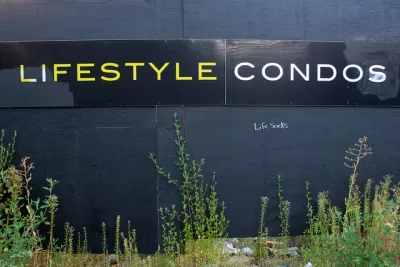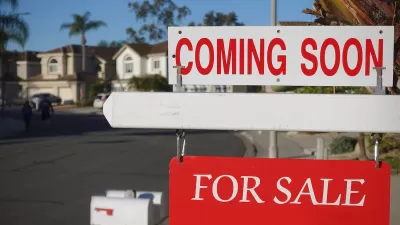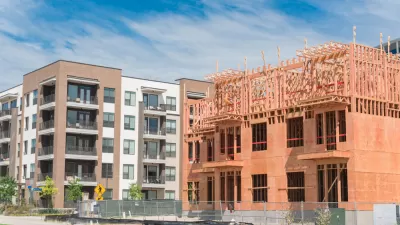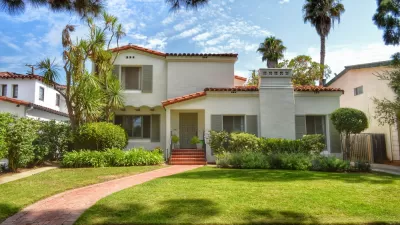Attempts to limit new construction to preserve neighborhood character are an example of "beggar thy neighbor" politics.

In an excellent blog post, Reuben Duarte explained that many big-city zoning disputes involve a conflict of visions: a "preservation camp" favors preserving neighborhood character at all costs, while an "affordability camp" favors construction of new housing in order to make the city more affordable.
Duarte write that the preservation camp's interests "hover around preventing evictions of tenants in long-held residences, but also includes the topics of traffic ("this neighborhood can't support more development, because, traffic!"), parking (replace "traffic" with "parking"), and neighborhood character ("building is too tall or too dense!" "Views!")."
It seems to me that to the extent government uses preservation as a reason to exclude new housing, arguments based on "neighborhood character" fail on their own terms: either because limiting housing supply itself changes neighborhood character, or because it forces less exclusionary places to change their character.
Zoning restrictions designed to limit traffic create the second problem. For example, suppose a city freezes a neighborhood's housing supply in order to limit traffic and parking. Other things being equal, fewer households mean fewer cars. So at first glance, this policy has no losers. But if a city or region is adding households, those new households have to go somewhere. And if they don't go to your neighborhood, they go to another neighborhood, adding cars (and thus traffic/parking problems) to that neighborhood.
To make matters worse, if the frozen neighborhood is more pedestrian-friendly than the "housing-receiving" neighborhood, freezing housing increases traffic everywhere. For example, suppose that the housing moratorium occurs in Pedtown, a neighborhood where 40 percent of households have no car, and 60 percent get to work without driving. The average household excluded by the moratorium moves to Sprawlville, a suburb where only 5 percent of the households have no car, and only 10 percent of them get to work without driving. Obviously, the new Sprawlville households are much more likely to drive cars throughout the region to work, thus increasing regional traffic and parking problems.
But zoning restrictions may also change the character of the neighborhood allegedly benefitting from them. Suppose a city freezes a neighborhood's housing supply in order to prevent gentrification and the resulting increase in rents. As long as demand is stagnant (for example, in a declining neighborhood) this policy has no real effect: no one will want to build new housing anyhow. But when demand is growing (either because of rising city population or rising city incomes) rents are likely, all else being equal*, to rise in the absence of new construction. If rising rents lead to more evictions, freezing supply is actually likely to lead to more evictions, not fewer evictions. (Of course, I am assuming that the new construction actually increases the neighborhood housing supply, which is not always the case. A new building that merely replaces an old building is obviously more problematic.)**
And if rents rise, that in turn defeats attempts to preserve the intangible "character" of the neighborhood. Even if a neighborhood's housing stock is frozen in amber, its character will be very different if it becomes more expensive. At a minimum, the inhabitants will be richer. And in turn, this reality will affect the age, race, and even religion of the neighborhood's inhabitants, to the extent that some races, ages, and religions have more money than others. If the neighborhood has commercial blocks, the shops may look very different if the neighborhood gets wealthier. For example, a street catering to wealthy 50 year olds will have somewhat different shops than one catering to not-so-wealthy 25 year olds.
Moreover, if housing restrictions in one neighborhood cause new housing to be built elsewhere in a region, the "receiving" neighborhood's character changes. Going back to Pedtown and Sprawlville: if Sprawlville was a rural, sparsely populated suburb in 2000, and zoning restrictions in Pedtown cause dozens of new subdivisions to be built in Sprawlville, obviously Sprawlville will feel very different in 2015. Thus, the restrictions in Pedtown are a classic example of a "beggar thy neighbor" policy—that is, a policy that shifts social harm from one neighborhood to another, rather than actually reducing the harm.
In sum, government sometimes restricts housing to preserve neighborhood character—but if those restrictions keep out new people and raise rents, that neighborhood's character will still change (albeit in different ways), and shifting populations will change the character of other neighborhoods.
*One huge caveat: this is not the case where supply creates its own demand: that is, where the new housing is so desirable that it not only commands higher rents than the existing housing supply, but also makes the neighborhood as a whole more popular, thus attracting new people even into the existing units. Certainly, a few neighborhoods have become much more desirable in recent decades (for example, New York's Williamsburg and Greenpoint)—so it could be argued that new housing in Williamsburg and Greenpoint is undesirable because it creates such demand. But this would only be the case if the new housing actually caused the increased demand rather than being a result of the increased demand. Moreover, housing restrictions based on this argument still create the "beggar thy neighbor" problem: if new housing is shifted to another neighborhood or suburb, how do we know that the new housing won't make that neighborhood more desirable?
**In addition, government can try to avoid this problem by limiting evictions in other ways—but this seems to me to be a separate issue.

Planetizen Federal Action Tracker
A weekly monitor of how Trump’s orders and actions are impacting planners and planning in America.

San Francisco's School District Spent $105M To Build Affordable Housing for Teachers — And That's Just the Beginning
SFUSD joins a growing list of school districts using their land holdings to address housing affordability challenges faced by their own employees.

The Tiny, Adorable $7,000 Car Turning Japan Onto EVs
The single seat Mibot charges from a regular plug as quickly as an iPad, and is about half the price of an average EV.

With Protected Lanes, 460% More People Commute by Bike
For those needing more ammo, more data proving what we already knew is here.

In More Metros Than You’d Think, Suburbs are Now More Expensive Than the City
If you're moving to the burbs to save on square footage, data shows you should think again.

The States Losing Rural Delivery Rooms at an Alarming Pace
In some states, as few as 9% of rural hospitals still deliver babies. As a result, rising pre-term births, no adequate pre-term care and "harrowing" close calls are a growing reality.
Urban Design for Planners 1: Software Tools
This six-course series explores essential urban design concepts using open source software and equips planners with the tools they need to participate fully in the urban design process.
Planning for Universal Design
Learn the tools for implementing Universal Design in planning regulations.
Smith Gee Studio
City of Charlotte
City of Camden Redevelopment Agency
City of Astoria
Transportation Research & Education Center (TREC) at Portland State University
US High Speed Rail Association
City of Camden Redevelopment Agency
Municipality of Princeton (NJ)






























